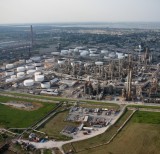UPDATE (Oct. 9, 2015): The Federal Railroad Administration (FRA) is expected to release new standards today that address track inspection and maintenance. This follows the administration’s eight-month investigation into the February oil train derailment in West Virginia, which found that broken rail caused the derailment.
Broken rails account for approximately 15 percent of train derailments – more than any other cause. Yet railroad companies are failing to identify and fix problems. In fact, CSX – the company that owned the track where February’s derailment occurred – identified issues with the section of track in the weeks preceding the accident but failed to take action.
The new standards will require railroad companies to fix rail issues or slow trains when crossing sections with safety issues.
UPDATE (May 1, 2015): The Pipeline and Hazardous Materials Safety Administration (PHMSA) and the Federal Railroad Administration (FRA) released their final rule today on crude-by-rail safeguards. These rules will apply to trains carrying certain amounts of flammable liquids, including Bakken crude oil and other flammable substances like ethanol.
The rule requires all tank cars constructed after Oct. 1, 2015 to have shells that are at least 9/16th of an inch thick. Older cars that do not meet this standard must be retrofitted within the next two to 10 years, depending on car type.
The rule also requires rail companies to adopt advanced braking systems over the next six to eight years, including electronically controlled pneumatic systems (ECP) that allow train cars to brake simultaneously and decrease stopping distances. The rule sets an overall speed limit of 50 mph for oil trains and a 40 mph limit for trains passing through densely populated urban areas while carrying cars not yet meeting the new tank car standards.
Unfortunately, the rule does not require railroad companies to notify state and local officials when they are moving crude and other hazardous materials through their jurisdictions. Instead, state and local decision makers must contact railroads to ask for routing information, and the companies are required to provide officials with the industry contact person who can address their questions. This is an unnecessarily roundabout way to disclose crucial information to those charged with protecting residents and businesses from health hazards and destruction in the event of an oil train derailment or explosion.
A bill introduced yesterday by seven Senate Democrats seeks to eliminate this communication gap and grant much-needed resources to local emergency response teams. It would require railroad companies to provide real-time data on train movements and would also raise revenue for advanced training on responding to oil train accidents. The bill would also speed up the phase-out of older, more dangerous tank car models.
UPDATE (Mar. 25, 2015): Sens. Maria Cantwell (D-WA) and Tammy Baldwin (D-WI) introduced legislation today that would create stronger crude-by-rail safeguards than those currently under review by the Office of Information and Regulatory Affairs. Among other things, the Cantwell-Baldwin bill would require the Pipeline and Hazardous Materials Safety Administration (PHMSA) to limit the volatile gases in crude oil that is transported by rail. The PHMSA and Federal Railroad Administration (FRA) rules currently under review require thicker tank car shells but do not regulate the crude itself, which is highly volatile and can explode during accidents.
The Cantwell-Baldwin bill would also ban certain classes of older tank cars, immediately removing 37,700 unsafe cars from use. It requires railroad companies to alert state and local emergency response officials when moving crude through communities and significantly increases fines for violations.
***
Original post from 2-18-2015
A 300-Foot High Fireball from an Exploding Bakken Oil Train: When Will New Rail Safety Standards Be Approved?
On Presidents' Day, a train carrying volatile crude oil derailed in Fayette County, West Virginia, igniting several railcars and creating a fireball 300 feet high. While no one was seriously injured, the incident is a stark reminder of the need for stronger safeguards to protect communities near the tracks that transport crude oil.

























